|
Recent Entries to this Blog
The Story of the Knights of the Round Dining Table Part 1
Posted: 12 Feb 2024 Posted: 21 Oct 2021 Posted: 21 Jul 2013 Posted: 28 Aug 2012 Posted: 21 Aug 2012 All Entries |
Droopy's Blog
Fairy tale characters
Category: Ramblings | Posted: Wed Nov 28, 2007 4:09 pm When Raoul and Christine meet again after many years in ëThe Phantom of the Operaû they recall reading to each other dark tales of the north. The Norwegian stories have figures like trolls, huldra, nøkken and other, more mysterious shapes. None of these are nice. None have a light spirit. All they want, is to make life miserable for man. The trolls are big, fairly stupid, often have many heads, and one eye between them, and have a stash of gold and valuables somewhere. They are known to capture lovely maids and lock them up inside strong castles, in mountains or underground. Huldra is a beautiful female, known to bewitch young men hunting or herding. She's a vision to look at and has a lovely voice, but her behind is hollowed in, and she's got a tail. Many youths lost their wits after encountering her, and many plainly disappeared, to stay with her underground, miserably, for ever. Huldra and her kind also used to sneak in to people's houses and swap their babies with one of their own. Nøkken lives in water. He likes to lure people to him and drown them, or bewitch them and steal their souls. He is known to play beautiful music on a fiddle, often by a waterfall, and specializes in stealing young maids. The sea version is both darker and more dangerous. Another important character is Tuftekallen, connected of the first person to clear the farm and build a home there. If he is treated right, he might help the people living on the farm, but if they forget to pay homage to him, woe and behold! The cattle will fall ill, the seed will go bad and other small or large unfortunate accidents will happen. There are many legends about him, but he's not normally part of the Norwegian fairy tales. My ancestors believed in these characters. They always wore a knife, to throw over any underground dweller's head in case they met one. Silver crucifixes were hung on cradles and worn always, to ward off huldra or nøkken. The trolls, well, there were many stories that told how to fool them, but the main goal would be to find out where they lived to steal their treasure. If you're very good, I might tell you a proper troll fairy tale tomorrow. This blog entry has been viewed 3188 times
The confession of a Pack Rat
Category: Ramblings | Posted: Tue Nov 27, 2007 8:02 pm I'm from a family of pack rats, and I've married into a family of pack rats. I've been unable to throw things out that I knew for certain I'll never use again, and nobody else will ever want to use it either. But what can I do? It's in my blood. Just look here: My grandmothers collected jam jars, bottles (they were glass back then), old clothes, magazines, newspapers and probably a lot more. There was a reason for their collection. The jam jars were reused. I remember the lovely, sweet smell of jam making permeating the whole house. The big jars held boiled pears that would serve as dessert through winter. The bottles were used for collecting milk, or for limonade made from redcurrants, blackcurrants or bilberries. Thick and lovely, with lots of sugar, mixed with water before drinking. The old clothes were made into woven mats and rugs, nice and thick for floors that would otherwise be bare and cold. The newspapers went to the outdoor loo. The magazines were used to start fires with, after all the recipes were cut out. They weren't so glossy then and burned well. My mother kept the tradition alive. She also hermetized pears, made jams and limonade and made new clothes out of old, unfashionable ones. She collected plastic containers of all kinds too, to freeze berries. After a time she came to realize that home made was more expensive than shop bought, and with long working hours she just didn't have time for domestic activities any more. She managed to throw the clothes away, realizing she didn't know how to weave, but she kept her stash of jars and bottles. Then it was my turn. I ended up saving jars and bottles, and made jams because I liked it and I knew what was in them. And plastic containers of all kinds for berries, soups, stews and such. And old clothes that were torn, out of fashion, with a broken zip or just worn out. Newspapers, of course. And boy, have I worked hard to make myself get rid of this! The glass jars are now recycled. I've kept the big, old ones that my husband inherited from his grandmothers by way of his mother (!). The plastic containers are also recycled. We only keep a couple now and then, because the girls like to use them for snow art and such. Then there's the clothes. I've cleared away the torn or worn out. Everything else has been sorted in bags and taken to the Salvation Army containers or one of the Church Aid dos. I actually manage not to keep things I know will never be used again. I'm proud of myself. My grandparents and parents lived through at least one war. They knew how to make the most of what they had, and were prepared for any shortage that might arise. I'm fairly confident I won't have to think like that, but the heritage has made me careful about wasting. Now all I have to do, is make sure my girls won't start on the same collection madness that the last three generations have suffered, but give them enough sense to realize that wasting is bad for them. This blog entry has been viewed 645 times
European mix?
Category: Ramblings | Posted: Sun Nov 25, 2007 10:12 am Around 1100 some 100 German towns made an alliance called the Hansa, to try and get trade monopoly and to protect their ships from pirates. Included in their alliance was Bergen, a town on the west coast of Norway. The Germans traded dried and salted fish, fish oil, feathers, fur and timber. Lots of German traders made their homes in Bergen, and skilled workers followed. The Hansa alliance died down around 1500, but the trade ways were still open. Many Germans never left Norway, but stayed and became Norwegians. The North Sea was a main trade route for hundreds of years, and with the weather and all the ships, there was bound to be tragedies and ship wrecks. Stories and legends show that ships sailing in the Spanish armada of 1588 were blown all the way up to Norway. These were not all Spanish ships, but also Dutch and German ships commanded by the Spanish Navy. Some survivors never bothered to go home, but stayed where they landed. In 1612, some Scottish soldiers hired to fight in Sweden tried to pass through Gudbrandsdalen. They were ambushed, many were killed and their Colonel Alexander Ramsey was sent on to Oslo. It is said that many of the Scots stayed in Gudbrandsdalen. The national costume from those parts has a tartan top, but it's not certain that it comes from the Scottish influence. A well-documented ship wreck is the ëAkerendamû that went down off the island of Runde on the Norwegian north west coast in March 1725. There were no survivors, but lots of salvage activity that was well documented at the time. In 1972 sports divers found the wreck and lots of treasure too! This ship was bound from Texel in Holland to Batavia (Djakarta) and was owned by Vereinigte Oostindische Compagnie. Stories are also told about Spanish sailors ending up in Røst, an island south of Lofoten, and similar stories are told up and down the coast. This might explain why so many Norwegians have near-black hair and olive skin. This blog entry has been viewed 619 times
The magic of words
Category: Ramblings | Posted: Sat Nov 24, 2007 10:33 am I like poetry. All kinds. I do not know how much I've read over the years, but on occasion some lines turn up, unbidden, in my mind. So, yesterday I decided to pursue the lines a bit further and see if I could find the authors and maybe a bit more of their works. I found Shakespeare's Sonets, some verses by Rudyard Kipling, Jacques Prévert's works, one by Joachim Ringelnatz, and a couple of half-forgotten Norwegian poems too. In short, I enjoyed poetry in four languages, and I feel terribly proud of myself. I am awed by the way some poets manage to bring feelings to the surface just by placing words in the right order, and using words to pinpoint their exact meaning. One of my favorites is very long. Another one has four lines. They both move me deeply. Once I read an Alexander Pushkin poem translated into English. I don't know Russian. It has stuck in this version until today. I loved you, and my love, I think is stronger than to be quite extinct within me yet. But let it not detain you any longer, I will not have you feel the least regret. I loved you bare of hope and of expression, with tenderness and shyness sore. I loved you with such purity and passion as God may grant you to be loved once more. Last edited: Sat Nov 24, 2007 10:35 am This blog entry has been viewed 478 times
I'm here but it was a close call
Category: Ramblings | Posted: Thu Nov 15, 2007 8:01 am When the fire destroyed our town, my great-grandfather decided not to stay and rebuild their home. He moved to an island not very far away and set up house there, a small farm and a fishing boat. 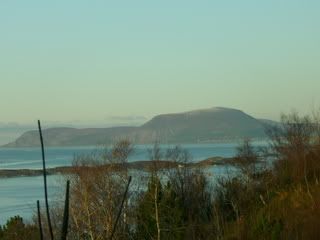
He lived to be nearly 94, and I remember him well. He had white hair and a yellow-streaked, big mustache. His eyesight was failing so I used to crawl about on the newspaper and read him the headlines. The paper was a big one, and I was small. My maternal grandmother grew up not very far from Lofoten, and she was sent to this island to help mind an old relative. She met my grandfather there. My father's mother went with her family to America as a child. They expected to settle there, but her uncle died, and her father brought the entire family back to take over the family farm. A good thing, because she met and married my paternal grandfather. Since my father grew up very far inland, and my mother grew up on an island, the chances that they should meet were slim. But, thanks to the Military who works in mysterious ways, my father ended up in the Navy and stayed in for years. I often think of all the coincidences that actually brought me to this world. How very glad I am that things turned out the way they did! This blog entry has been viewed 617 times
Up from the ashes
Category: Ramblings | Posted: Tue Nov 13, 2007 7:53 pm Since I've told you about the fire that destroyed most of my home town, I would also like to show you what came out of it: 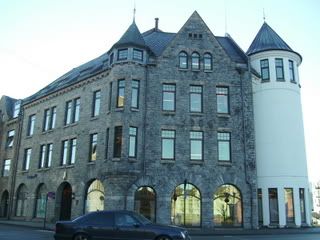

This lovely house used to be a pharmacy well into the '80s and maybe longer, but is now an Art Nouveau museum: 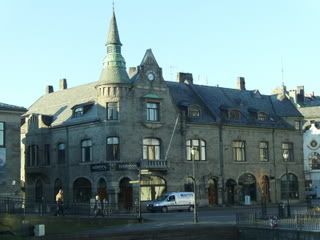
This is Brosundet, now mostly hotels and apartments: 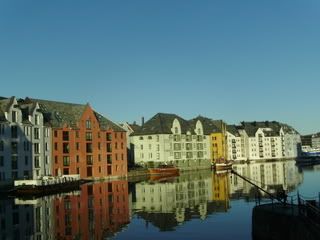
MoljÃÂ¥, the gateway to the harbour: 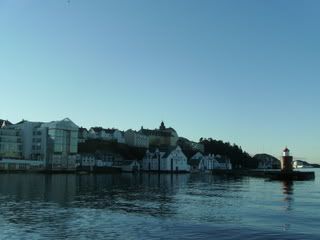
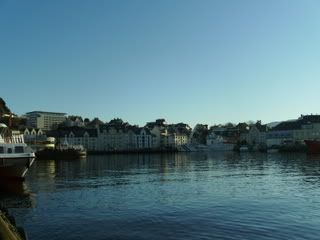
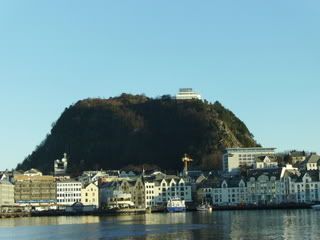
A view from the top of the mountain: 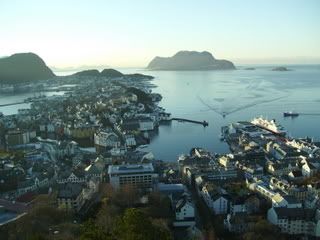
I had company while admiring the view: 
Some details: 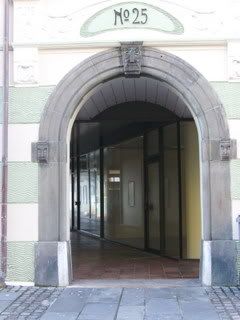
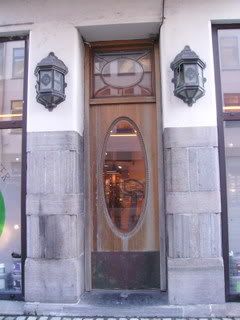
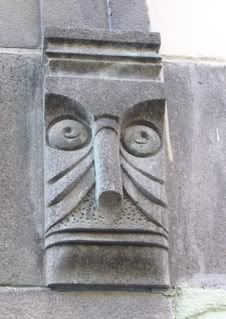
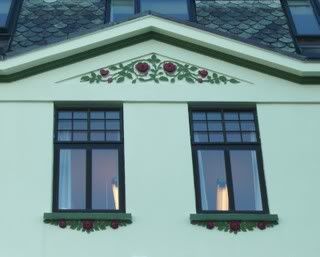
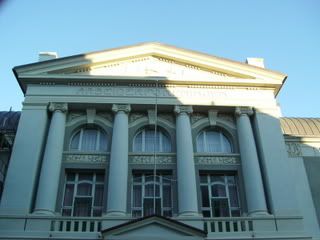
This blog entry has been viewed 648 times
The fire that made a pearl
Category: Ramblings | Posted: Mon Nov 12, 2007 8:55 am Imagine lying in your bed at two A.M. It's January, and it's cold outside. Suddenly you are woken by the tolling of the bells. There's a fire to the west, there's a storm on and you had better pack up and flee! What to bring... And with what to bring it! Qickly the hand cart is packed up, your old, infirm aunt is put in there along with what valuables and necessities you have time to pack, and you start walking westward with thousands of other refugees. Turning back, you can see the red of the flames and hear the roar as they devour the eastern part of your home town. Will the fire brigade manage to stop this? 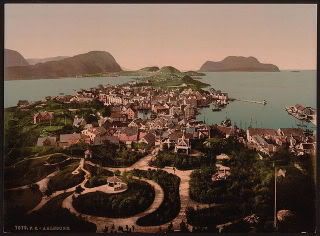
The only sounds heard are the roaring from behind, the howling of the wind and the slushy sounds from thousands of suddenly homeless souls that trudge silently along, their faces shocked and panicked, eyes staring stiffly ahead. Yes, it is a very silent exodus. The reality is too horrifying to talk about just yet. But there is help. The first houses on the outskirt of the town are already filled up, but you're told to keep walking. Further along others are waiting to take you in, or help you along if that's what must be done. Finally you get welcomed in by a friendly farmer who just cleared a space in his barn. Your aunt is brought inside, there is soup, and you make yourself as comfortable as you can, all the time fretting and worrying about your home. After more than 20 hours the fire was under control, but not much was left. 850 buildings were gone, and about 230 were left inside the town border. These were not all homes but also barns, storage houses and such. More than 10.000 people were homeless, but only one life had been lost. Many Norwegian papers printed the story of the fire this Saturday 23d of January 1904. They had received telegrams about the fire, and knew help was needed. The Chief of the fire brigade, having successfully gotten the flames under control, went to send a telegram report to the government late Saturday evening. While sitting in the telegraph office a message ticked in from Kaiser Wilhelm II of Germany. He had heard about the terrible fire, and was already loading food, clothes, medicines and other aid onto ships in Hamburg and Bremerhafen. Help started coming in early Sunday morning, and three days after the fire, the Kaiser's ships arrived. Mrs. Sarah Bernard held a matiné in Paris to the aid of the fire victims. Money were sent from all over the world, for example from Chicago USA, Leith in Scotland, Rio de Janeiro, and even from Africa. The fire over with, and the cleaning-up done, one would have to rebuild. This time, no wood! The town would be built in stone. And the year being what it was, all architects flocking to Ãâ¦lesund brought with them a new way to build. The Art Nouveau or Jugend style. And since town planning was rather new, all houses were built differently, according to the taste and money of the owners and the quirks of the architects. 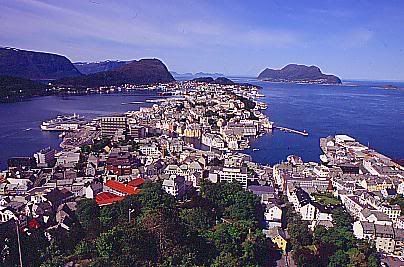
This blog entry has been viewed 644 times
Lawn - what lawn?
Category: Garden | Posted: Fri Nov 09, 2007 8:25 am When we bought our home, it was surrounded by lawn. Yep, all four sides of it. But "lawn" might not be the right word... The back looked more or less like a collection of various moss. The east side and front seemed to be humps or dumps with grass and more moss. The bit to the west was actually rather nice, but very big. We brought a battery powered lawn mower with us in the car. That was our first piece of "furniture" - everything else arrived later that day. The first year we spent redecorating the interior and mowing the lawn. The next year we decided we did not want all that grass around. So we started transforming the lawns into something we didn't have to mow. The back is now covered with stone, two raised beds and a messy under-construction-zone. The east and south bit is an acid soil bed with hostas, lilies, trilliums, rhododendron, heathers and what-not. It looks rather nice. To the west, we're still working on how to reduce the amount of flat greenery. We've made three flower borders, half a hosta walk, some steps that we call a donkey stair case and a sand box for the girls. Now, why do we want rid of the lawn? Well, the mower's battery got poorer each year, so we had to decrease lawn size in order to get everything mowed in one charge. Then we've got this unstable weather. Mowing wet lawn is a patience-trying experience, and having to do that all summer is really not much fun. In addition to that, there's moss. Some patches were all moss and no grass, and after having watched the neighbour spending a week removing moss, redressing lawn and tidying up, just to have a nice lawn for only two years, we realized that either we kept the moss or got rid of more lawn. And to top things off, we're getting short of border space. A fact I believe many Stewbees can relate to. We'll keep some lawn of course. It's nice to walk barefoot on the grass. But the size will be no more than a tennis court, that will have to do. This blog entry has been viewed 623 times
Cabins and such
Category: Ramblings | Posted: Thu Nov 08, 2007 9:21 am Most Norwegians have to have a cabin, somewhere primitive out of the way to retreat and reacharge during the week-ends, preferably in a mountain somewhere. Well, that was propably the general idea, but this is not how it works anymore. We've got small cabins up in the mountains and down by the fjords, but they are disappearing or falling into disuse fast. People want holiday homes, with all the luxuries and comfort of their home, or even better. Some years back, cabin owners would load up their cars with everything needed and set out to brave bad roads or no roads to be able to spend some time with no electricity, outside toilet, wash basins and manual labour, and not a neighbour in sight. The parents had their own bed room, but everybody else would sleep in the only other room available, the living room. In winter the place would be getting warm just about when it was time to go home. The car was parked some way off, but the going would be easy in winter because of the skis. Without them you wouldn't be able to get there. The goal of the trip would be to ski or walk, enjoying the peace and quiet, and the scenery. Now they want to drive to a pre-heated place with a garage, jacuzzi, sattelite dish, a shop close by, and even your next-door-neighbour next door. The place is big enough to accomodate the owner's family and a couple of visiting families, and might even have a guest house, just in case the place gets cramped. The scenery is exchanged for a view of lots of cabins looking very much like your own. As for the peace and quiet - well, there's a night club a couple of blocks down, and the after-ski taverna by the bottom of the slope is just an easy stroll away. Some hard-core cabin owners refuse to give in totally, but with the children bending their ears about not being able to use their laptops or video games during the week-ends, they give in and install solar panels and running water for starters. I'm not one to complain about progress, but I do feel we lost something along the way. And I don't even own a cabin! This blog entry has been viewed 588 times
I'm terribly excited
Category: Ramblings | Posted: Tue Nov 06, 2007 5:00 pm Yesterday I was told I'm to be a Granny again around May 22d. I'm really looking forward to a new baby to cuddle, but it's early days yet. Only 11 weeks. I saw the ultrasound pictures today, the tiny thing is nearly 4 cm long. My little finger is longer. The soon-to-be big sister was ecstatic when told. No wonder! She's been sneaking up to prams to admire babies for years, and have told the proud parents how she longs for a sibling. Her parents tried to make her understand what she'll be to the new baby, and they hinted and coaxed her to say it herself. "When the baby comes, what does that make you then? What will you be?" She was really thinking hard, then suddenly her face lit up in a big, wide grin and answered: "I'll be HAPPY!" She refused to attend kinder garten today, because she wanted to stay at home with mommy and the tummy. Yes, she said that. In Norwegian, of course. I'm predicting a very long, impatient wait for her. Me, I've just ordered some baby alpacca yarn. I want to knit a blanket. This blog entry has been viewed 652 times
You're reading one of many blogs on GardenStew.com.
Register for free and start your own blog today. |
Archives
All Entries |
